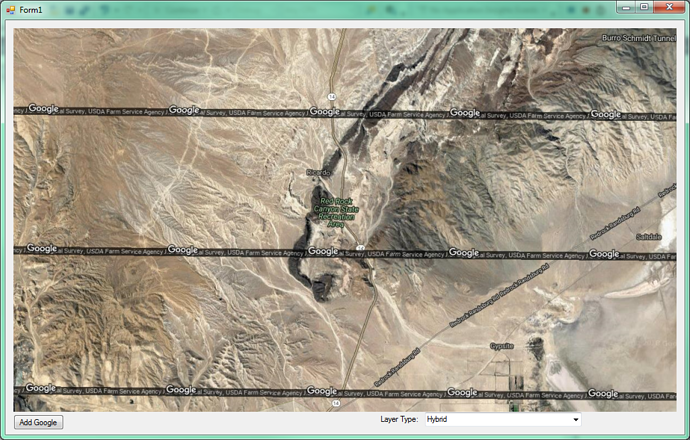Hi,
Google map layer fails in v10, but works in v9.
at System.RuntimeTypeHandle.CreateInstance(RuntimeType type, Boolean publicOnly, Boolean noCheck, Boolean& canBeCached, RuntimeMethodHandleInternal& ctor, Boolean& bNeedSecurityCheck)
at System.RuntimeType.CreateInstanceSlow(Boolean publicOnly, Boolean skipCheckThis, Boolean fillCache, StackCrawlMark& stackMark)
at System.RuntimeType.CreateInstanceDefaultCtor(Boolean publicOnly, Boolean skipCheckThis, Boolean fillCache, StackCrawlMark& stackMark)
at System.Activator.CreateInstance(Type type, Boolean nonPublic)
at System.RuntimeType.CreateInstanceImpl(BindingFlags bindingAttr, Binder binder, Object[] args, CultureInfo culture, Object[] activationAttributes, StackCrawlMark& stackMark)
at System.Activator.CreateInstance(Type type, BindingFlags bindingAttr, Binder binder, Object[] args, CultureInfo culture, Object[] activationAttributes)
at System.Activator.CreateInstance(Type type, Object[] args)
at ThinkGeo.MapSuite.Portable.PclSystem.<>c__182.<Register>b__18_0(IPclSystem s, Object[] args) at fSQ=.lCQ=.<>c__DisplayClass2_0.<.ctor>b__0(IPclSystem ioc, Object[] args) at fSQ=.iiQ=.kyQ=(IPclSystem ioc, Object[] args, Boolean createNew) at fSQ=.lCQ=.lyQ=(IPclSystem ioc, Object[] args, Boolean createNew) at ThinkGeo.MapSuite.Portable.PclSystem.Resolve[T](Boolean createNew, String label, Object[] args) at ThinkGeo.MapSuite.Portable.PclSystem.Resolve[T](String label, Object[] args) at ThinkGeo.MapSuite.Portable.PclSystem.get_GeoRasterProjectionWrapper() at ThinkGeo.MapSuite.Shapes.Proj4Projection.ConvertToExternalProjectionCore(GeoImage image, RectangleShape imageExtent) at ThinkGeo.MapSuite.Shapes.Projection.ConvertToExternalProjection(GeoImage image, RectangleShape imageExtent) at ThinkGeo.MapSuite.Layers.GoogleMapsLayer.IDY=(GeoCanvas canvas) at ThinkGeo.MapSuite.Layers.GoogleMapsLayer.DrawCore(GeoCanvas canvas, Collection1 labelsInAllLayers)
at ThinkGeo.MapSuite.Layers.Layer.ciU=(GeoCanvas canvas, Collection1 labelsInAllLayers) at ThinkGeo.MapSuite.Layers.Layer.Draw(GeoCanvas canvas, Collection1 labelsInAllLayers)
at ThinkGeo.MapSuite.WinForms.LayerOverlay.DrawCore(GeoCanvas canvas)
at ThinkGeo.MapSuite.WinForms.Overlay.YlM=(GeoCanvas canvas)
at ThinkGeo.MapSuite.WinForms.Overlay.Draw(GeoCanvas canvas)
at ThinkGeo.MapSuite.WinForms.WinformsMap.G1M=(IEnumerable`1 drawingOverlays, RectangleShape extent)
at ThinkGeo.MapSuite.WinForms.WinformsMap.GlM=(RectangleShape drawingExtent, RectangleShape extent)
at ThinkGeo.MapSuite.WinForms.WinformsMap.OVM=(RectangleShape extent)
at ThinkGeo.MapSuite.WinForms.WinformsMap.gRU=(Int32 delayInterval, RectangleShape extent)
at ThinkGeo.MapSuite.WinForms.WinformsMap.Refresh()
at GoogleMapOverlay_v9.Form1.btnAdd_Click(Object sender, EventArgs e) in c:\Users\damian\OneDrive - acteq.net\Visual Studio Projects\Projects\GoogleMapOverlay_v10\GoogleMapOverlay_v9\Form1.cs:line 95
at System.Windows.Forms.Control.OnClick(EventArgs e)
at System.Windows.Forms.Button.OnClick(EventArgs e)
at System.Windows.Forms.Button.OnMouseUp(MouseEventArgs mevent)
at System.Windows.Forms.Control.WmMouseUp(Message& m, MouseButtons button, Int32 clicks)
at System.Windows.Forms.Control.WndProc(Message& m)
at System.Windows.Forms.ButtonBase.WndProc(Message& m)
at System.Windows.Forms.Button.WndProc(Message& m)
at System.Windows.Forms.Control.ControlNativeWindow.OnMessage(Message& m)
at System.Windows.Forms.Control.ControlNativeWindow.WndProc(Message& m)
at System.Windows.Forms.NativeWindow.DebuggableCallback(IntPtr hWnd, Int32 msg, IntPtr wparam, IntPtr lparam)
at System.Windows.Forms.UnsafeNativeMethods.DispatchMessageW(MSG& msg)
at System.Windows.Forms.Application.ComponentManager.System.Windows.Forms.UnsafeNativeMethods.IMsoComponentManager.FPushMessageLoop(IntPtr dwComponentID, Int32 reason, Int32 pvLoopData)
at System.Windows.Forms.Application.ThreadContext.RunMessageLoopInner(Int32 reason, ApplicationContext context)
at System.Windows.Forms.Application.ThreadContext.RunMessageLoop(Int32 reason, ApplicationContext context)
at System.Windows.Forms.Application.Run(Form mainForm)
at GoogleMapOverlay_v9.Program.Main() in c:\Users\damian\OneDrive - acteq.net\Visual Studio Projects\Projects\GoogleMapOverlay_v10\GoogleMapOverlay_v9\Program.cs:line 19
at System.AppDomain._nExecuteAssembly(RuntimeAssembly assembly, String[] args)
at System.AppDomain.ExecuteAssembly(String assemblyFile, Evidence assemblySecurity, String[] args)
at Microsoft.VisualStudio.HostingProcess.HostProc.RunUsersAssembly()
at System.Threading.ThreadHelper.ThreadStart_Context(Object state)
at System.Threading.ExecutionContext.RunInternal(ExecutionContext executionContext, ContextCallback callback, Object state, Boolean preserveSyncCtx)
at System.Threading.ExecutionContext.Run(ExecutionContext executionContext, ContextCallback callback, Object state, Boolean preserveSyncCtx)
at System.Threading.ExecutionContext.Run(ExecutionContext executionContext, ContextCallback callback, Object state)
at System.Threading.ThreadHelper.ThreadStart()
See attached test project.
Regards,
Damian
GoogleMapOverlay_v10.zip (372.4 KB)



